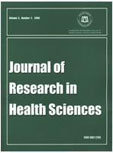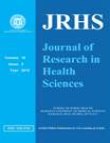فهرست مطالب

Journal of Research in Health Sciences
Volume:7 Issue: 1, Winter-Spring 2007
- 52 صفحه،
- تاریخ انتشار: 1386/09/01
- تعداد عناوین: 8
-
Page 1BackgroundEvaluation of exposition to Volatile Organic Compounds (VOC) and compare urinary level of urinary biological exposure index in sweepers in West of Iran.MethodsThis study was carried out on 40 street sweepers and 40 non-exposed as control group liv ing in Hamadan City, west of Iran. VOC was analyzed using gas chromatography equipped with a Flame Ionization Detector (FID). The urinary biological exposure index (BEI) was analyzed with High performance Liquid Chromatography (HPLC) equipped with an ultraviolet (UV) detector. The con centration of benzene, toluene, m & p-xylene o-xylene and ethyl benzene was 39.01, 121.60, 27.12, 12.30, and 10.21 (?g/m3), respectively.ResultsNo-difference in the levels of hippuric acid in urine was found in sweepers compared with the con trol group. Significance differences in the level of o-cresol in urine were found in sweepers compared to con trol group (P< 0.005). The poor correlation coefficient was seen between xylenes con centration and urinary MHA for drivers.ConclusionHigh VOC are emitted inside of cities at Iran. O-cresol could separate the exposed to toluene from the non-exposed in sweepers. Hippuric acid, methyl hippuric acid and muconic acid are not suitable biomarkers for occupations such as sweepers exposure to VOC in low concentration.
-
Page 6BackgroundYoung people engage in risky behaviors unintentionally and these behaviors might be re duced or inhibited by preventative behaviors. Although adolescents'' risky behaviors are known as un planned or unintentional, preventative behaviors are intentional. The aim of the present study was to as sess students’ behavior intentions to avoid drug abuse.MethodsThis study was a cross sectional design that male high school students (n= 176) in Tehran, Iran completed a questionnaire assessing behavior intentions to avoid drug abuse, self-control, self-effi cacy, perceived susceptibility, and negative attitudes toward drug abuse, peer resistance skills and sub stance abuse related behaviors.ResultsPeer resistance skills, negative attitude toward drugs, perceived self- efficacy, and high self-con trol were four predictors on intention against drug abuse. Moreover, students’ educational status, inter ested in school and truancy and spending with friends were other predictors for intention against drug abuse.ConclusionHealthy behaviors are intentional. As a result improving behavior intentions to avoid drug abuse would act as a protective factor for preventing drug abuse among adolescents as well as prevent ing high-risk behaviors.
-
Page 13BackgroundThe recognition of road traffic noise as one of the main sources of environmental pollu tion has led to develop models that enable to predict noise level from fundamental variables. Traffic noise prediction mod els are required as aids for designing roads and highways. In addition, sometimes are used in the assess ment of existing or envisaged changes in traffic noise conditions. In this paper a statisti cal modelling ap proach has been used for predicting road traffic noise in Iranian road condi tions.MethodsThe study was performed during 2005-2006 in Hamadan city, in the west of Iran. The data set con sisted of 282 noise measurements. The entire data set was utilized to develop a new model for Ira nian condi tion using regression analysis.ResultThe developed model has twelve explanatory variables in order to achieve a proper fit for meas ured val ues of Leq (r2= 0.913).ConclusionThe proposed road traffic noise model can be effectively used as a decision support tools for predic tion of traffic noise index of Leq(30min), in Iran''s cities.
-
Page 18BackgroundSeveral epidemiological studies suggest that tobacco smoking increases the risk of oral can cer. No systematic review, however, has been reported to examine how consistent the evidence is across the studies. We undertook a meta-analysis of epidemiological studies investigating the magni tude relationship between tobacco smoking and oral cancer.MethodsPrimary studies were identified through a computerized literature search of Medline. Arti cles abstracted were all epidemiological studies published as original articles in English during 1990-2007 provided the summary estimates of odds ratios (OR) of tobacco smoking for oral cancer com pared to that of non-smokers. A total of 15 case-control studies were used for this meta-analysis. Sum mary of OR was calculated based on random effects model.ResultThe combined odds ratio for tobacco smoking related to oral cancer was 4.65 (95%CI, 3.19-6.77). Also, the highest combined odds ratio was belong to America continents (OR= 7.65; 95%CI, 5.11-11.45) and the lowest was in Asia (OR= 1.88; 95%CI, 0.95-3.71). There was heterogeneity in the pooled OR estimate across the studies.ConclusionOur results clearly indicate that tobacco smokers are at increased risk of oral cancer. The can cer risk can be reduced by controlling of tobacco smoking in different countries.
-
Page 24BackgroundTo determine the prevalence and patterns of Complementary and Alternative Medicine (CAM) use in urban population in Isfahan.MethodsIn a cross–sectional study through two-stage sampling methods, 870 individuals were se lected from Isfahan Province, center of Iran. We selected 20 clusters randomly and chose one house hold from each cluster by chance then 24 households were included consequently. Subsequently a resi dent of each household aged 18 years or older was selected randomly. We assessed the rate of use, types of alternative medicine, and conditional disease during recent two years.ResultsThe overall use of at least one method of complementary and alternative medicine was 62.5%. The most common problems were as follows: digestive problem, obesity and hyperlipidemia, as well as anxiety and depression. Herbal medicine and bless therapy were the most common methods that peo ple chose.ConclusionRegarding to high prevalence of complementary and alternative medicine use, more atten tion to complementary and alternative medicine is mandate for physicians and health system manag ers. Health authorities'' supervision and training of traditional practitioner is important not only for its economic impact and postponement of seeking treatment, but also for its untoward side-effects ei ther alone or in combination with orthodox medicines.
-
Integrated Health, Safety, Environment and Ergonomic Management Systems for IndustryPage 32BackgroundConventional health, safety and environment (HSE) are a widely used approach to en hance availability and efficiency of complex systems. The integrated HSEE system is defined however as integration of conventional HSE with ergonomics approach. The presented HSEE system introduces a unique, effective and systemic mechanism, which integrates the structure of the human and organiza tional systems with conventional HSE system. It is utilized to enhance reliability, availability, maintainabil ity and safety through the proposed integrated framework of this study.MethodsThe integrated HSEE is developed by integration of conventional HSE with job systems by re-engineering organizational structures and teamwork through electronic data interchange (EDI). To show the need for and superiority of HSEE over conventional HSE to gas Treatment Company was stud ied and questionnaires were collected and examined with respect to distinct components of HSEE.ResultsThe main result of this study is a framework for development of integrated intelligent human engi neering environment in complex critical systems.ConclusionThe presented HSEE system introduces a unique, effective and systemic mechanism, which integrates the structure of the human and organizational systems with conventional HSE system.
-
Page 43BackgroundTo determine any correlation between infertility and semen quality with concentrations of L-carnitine in human seminal plasma.MethodsThis case-control study performed in Fatemieh Hospital in Hamadan, Iran. Seminal plasma of 72 infertile men and 80 men with proved fertility as a control group was investigated and L-car nitine level was determined using UV enzymatic test at 340 nm.ResultsThe concentration of L-carnitine was significantly lower in the infertile group compared with con trol group (80.59?56.43 mg/l versus 108.43?42.26 mg/l; P= 0.0009). There was also a statistically signifi cant positive correlation between seminal plasma L-carnitine concentration, total sperm count, and the percentage of motile sperm (P= 0.0009, and P= 0.0000, respectively).ConclusionThese finding suggest that the determination of seminal plasma L-carnitine level may be a useful test in evaluation of male infertility.
-
Page 49BackgroundTo determine the prevalence of typhoidal and non-typhoidal Salmonella species in Hama dan City, west of Iarn and detection of antibiotic susceptibility patterns of isolates.MethodsIn a cross-sectional descriptive study, 296 Salmonella species including 192 strains of typhoi dal Salmonella and 104 strains of non- typhoidal Salmonella were examined for serotyping and deter mining of antibiotic susceptibility. The strains were collected from patients referred to cilinical cen ters in Hamadan during 2001 to 2004. They were serotyped and then tested for their antibiotic suscepti bility patterns, using Stokes disc diffusion method for 8 antibiotics.ResultsAmong 296 samples, 64.8% were typhoidal and 35.2% were non-typhoidal Salmonella spe cies. Typhoidal Salmonella species were as follows: S. typhi 45.6%, S. paratyphi B 8.1%, S. paratyphi C 7.1% and S. paratyphi a 4.7%. Non-typhoidal Salmonella species were as follows: S.typhimurium 21.2%, S.enteritidis 4.4%, S. species 2.1%, S. cholerasuis 1.7%, S. arizona 1.3%, S. agona 1.1%, S. thomp son 0.7%, S.muenchen, S.lexington and S. hirschfeldii 0.35%. A proportion of strains (>60%) were resistance to cefotaxime and ampicillin. Resistance to ciprofloxacin and amikacin was very low (<15%). S.typhimurim (100%), S. typhi (95.7%) S. paratyphi B (89.2%) and S. enteitidis (60%) showed multi-drug resistance.ConclusionS. typhi and S. typhimurium were the most predominant serotypes in this area. Most of the Salmonella species isolated from patients were resistant to beta-lactam antibiotics and co-trimoxa zole, whereas, most of them were sensitive to ciprofloxacin, gentamicin and amikacin. As the preva lence of multidrug-resistant serovar Typhi increases, newer, more expensive, and less readily available an timicrobial agents will be required for the treatment of typhoid.


